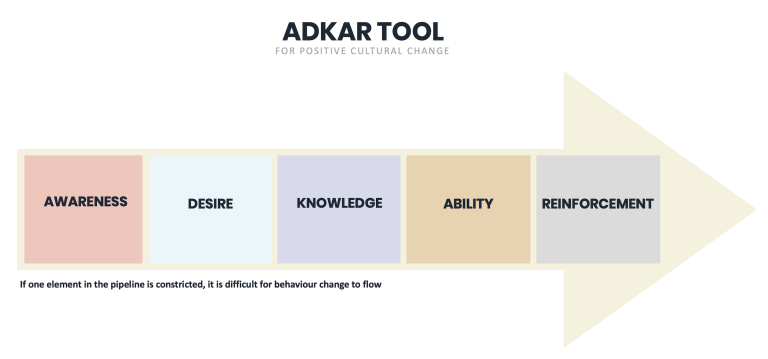Human resource practice
There are a range of tactics that you can use throughout the employment cycle to prevent sexual harassment or reduce the risk of it occurring in the workplace.

Internal management practices are important to achieve and reinforce your desired culture. There are a range of tactics that you can use throughout the employment cycle to prevent sexual harassment or reduce the risk of it occurring in the workplace. For large organisations with separate teams responsible for risk, HR, finance etc, a cross-functional approach is required to ensure functions are working together to align people management practices to ensure cohesion and bring them to life in a collaborative way.
In this section we will consider human resource practice in relation to:
- Reward and recognition
- Performance management
- Recruitment and induction
- Talent management and promotion
- Stakeholder engagement and change management
Reward and recognition
Your reward approach can be used to positively influence worker behaviour and create a culture that discourages sexual harassment. It should consider what people deliver and how they demonstrate the desired values and behaviours. For example, if you have a stated value of “respect” people should be rewarded for demonstrating respectful behaviour and penalised for disrespectful behaviour.
In turn, this creates a powerful incentive for workers to engage in respectful behaviour and contribute to a positive workplace culture. Practical considerations such as the weighting that you assign to “what” (results) versus “how” (behaviours) also delivers an important message. For example, assigning a 50:50 weighting indicates that results and behaviours are equally important. Alternatively, demonstrating the values and behaviours could be a baseline requirement to be eligible for financial incentives. High value workers who make a lot of money for their organisation or hold a critical role should be held to the same behavioural standards as others.
In larger organisations, there is an opportunity to align company-wide scorecards and incentive systems to discourage sexual harassment. For example, measures of inclusion and diversity might form part of your company scorecard and influence executive pay.
Make sure your reward strategy doesn’t inadvertently encourage behaviours that are inconsistent with your values. For example, putting more emphasis on performance outcomes than behaviours will undermine the importance of your core values. Consideration should be given to including an overlay to your reward strategy, articulating an explicit set of questions around behaviour and how this has been effectively demonstrated.
Recognition also plays a powerful role in activating and embedding the desired culture. Consider how you can include informal recognition in your everyday practices. For example, dedicate time in a team meeting to acknowledge individual behaviours that align with the values and call out team wins. In larger organisations, supplement informal recognition with more formal approaches such as:
- A company-wide recognition program that publicly showcases individuals and teams who demonstrate the values.
- An online recognition platform that enables peer and management recognition, and positively reinforces the desired values and behaviours.
Performance management
Culturally aligned performance management processes should differentiate people who behave in accordance with the desired culture and align with the core values. For example, performance management processes that reinforce continuous feedback, coaching and learning are consistent with core values of inclusion and learning. These processes promote a workplace where it’s okay to speak up and continuous improvement is encouraged. In contrast, performance management systems that promote forced ranking can lead to fear of failure and hinder innovation and learning agility. .
Recruitment and induction
Your organisation’s recruitment practices should aim to hire diverse applicants with strong values alignment. To assist you can:
- Share stories on your organisation’s careers webpage that bring your organisational values to life (e.g. videos or profiles of real employees)
- Ask interview questions to explore the values that are important to applicants and elicit examples of respectful and inclusive behaviours.
- Use psychometric assessment to evaluate behavioural preferences and alignment with your core values.
- Explore the applicants’ values and commitment to gender equality in reference checking; gather information about their interpersonal style and support for diversity and inclusion.
- Reinforce the importance of a harassment-free workplace at every step in the process.
- Introduce training to “manage unconscious biases” for all people leaders.
A rigorous screening process is particularly important in leadership roles and other critical roles that infer positional power. Consider a combination of background checking and reference checking with questions to elicit specific information relevant to sexual harassment such as support for gender equality and respectful behaviours.
Example Interview and Reference Checking Questions to Assess Values Alignment can be downloaded here.
Induction processes should reinforce your commitment to a harassment-free workplace and clarify core values and behaviours. In small organisations this may be the responsibility of the leader. In large organisations this should include mandatory training to take new workers through your code of conduct and relevant policies. Tools such as videos and people profiles can also be used during induction to bring your culture to life.
A note on recruiting for culture fit: Many organisations have historically recruited for “culture fit.” This should be replaced by a focus on “values alignment” and addressing unconscious biases. Together these two focus areas promote diversity, whilst reinforcing the values that reflect your organisation at its best.
Talent management and promotion
Similar to external recruitment decisions, internal talent practices should consider values alignment. This includes succession management, identification and development of ‘high potentials,’ and promotions.
It is also good practice to identify and evaluate any substantiated cases of misconduct relating to internal candidates before making an appointment decision. Consider when the misconduct occurred, its nature, severity, and relevance based on the requirements of the target role and values alignment. In some cases, sexual harassment will be a barrier to advancement, including as a delay in promotion. As always, it will be important to ensure transparency of such decisions with the individual involved.
Stakeholder engagement and change management
Culture change relies on the active participation of a critical mass of your workforce. Approaches to stakeholder engagement and change management will vary depending on your organisation’s size, resources and available expertise. Some organisations will have dedicated change managers and an established change methodology, while others will rely on leaders with limited change experience. Regardless, change management is an important consideration to deliver positive culture change.
Prosci (“Professional + Science = Prosci”) is a leading change management research and advisory practice. The Prosci ADKAR model acknowledges that effective change happens one person at a time and is a useful tool to plan how you will achieve collective ownership of culture change.

An ADKAR tool for positive culture change for the prevention of sexual harassment can be downloaded here.

